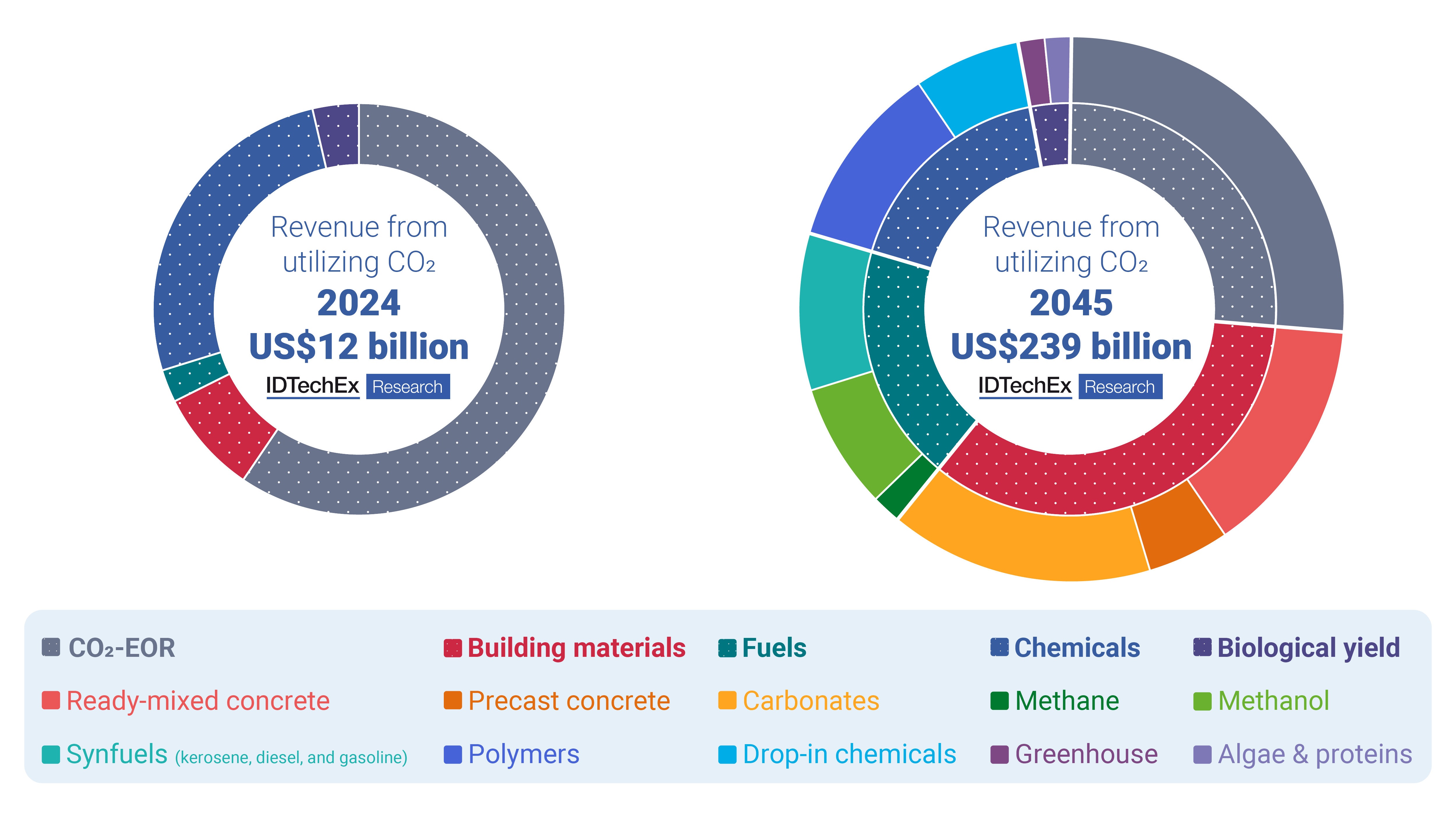IDTechEx: CO2 Utilization Market to Grow To US$240 Billion by 2045
Author: Eve Pope, Technology Analyst at IDTechEx
Carbon capture technologies capable of removing CO2 from industrial emissions have been around for over 50 years, but widescale deployment of CCUS (carbon capture, utilization, and storage) has been too slow for global net-zero ambitions. While governments are beginning to implement carbon pricing mechanisms or tax credits to motivate permanent storage of CO2 deep underground, a profitable business model exists beyond CO2 sequestration via emerging CO2 utilization applications. According to the new IDTechEx research report, “Carbon Dioxide Utilization 2025-2045: Technologies, Market Forecasts, and Players”, sales from CO2 utilization will directly generate US$240 billion in revenue in 2045.

Breakdown of how the share of direct revenue from the sale of CO2 utilization product for each category will change over the next twenty years. Additional revenue streams such as 45Q tax credits, carbon credit sales, and waste disposal fees are not included. Source: IDTechEx
Carbon dioxide utilization technologies recycle captured CO2. The new carbon-containing products can be sold to generate financial benefits while offering a reduction in carbon footprint. The leading fate of captured carbon dioxide today is enhanced oil recovery – a method of reversing productivity decline in depleted oil fields. However, there are many emerging areas of CO2 recycling, including CO2-derived concrete, CO2-derived fuels (methane, methanol, kerosene, diesel, and gasoline), CO2-derived chemicals, and CO2 yield boosting applications (crop greenhouses, algae, and proteins).

The CO2 utilization categories covered in the new IDTechEx CO2 utilization report. Source: IDTechEx
Chemicals made from captured CO2 are already profitable
Profitable production of CO2-derived polymers has been around for decades. Asahi Kasei pioneered production of polycarbonate from waste CO2 in 2002. The total annual production capacity of polycarbonate resin using CO2 utilization technology has now reached about 1 million tonnes. Other essential plastics, such as polyethylene and PET, are starting to be made from CO2 via thermochemical and biological conversion routes, with LanzaTech leading microbial innovation in this space. Drop-in chemicals such as CO2-derived ethanol and aromatics are also being commercialized.
While potentially all carbon-containing chemicals could utilize carbon dioxide in production, those requiring non-reductive pathways are the most promising due to a smaller energy demand and lack of dependency on low-carbon hydrogen production. The new IDTechEx report “Carbon Dioxide Utilization 2025-2045: Technologies, Market Forecasts, and Players” explores synthesis routes for chemical companies to use waste CO2 as a green feedstock, displacing petrochemical products.
CO2-derived fuels could decarbonize the aviation and shipping sectors
To date, alternative fuels have not achieved price parity with fossil fuels, inhibiting market uptake. However, increased market penetration of CO2-derived fuels is expected to come from regulations already being put in place, such as fuel-blend mandates for long-haul transportation. As green hydrogen electrolyzer capacity scales up worldwide, production of e-fuels from carbon dioxide using power-to-x technology will also increase. These fuels are expected to play a role in decarbonizing shipping and aviation as full electrification of the aviation and maritime sectors is currently unfeasible.
Several CO2-derived fuels are already being commercially produced with many more commercial facilities expected over the next decade. The start of 2024 saw Mitsui and Celanese’s joint venture Fairway Methanol become operational, joining plants from Carbon Recycling International in producing over 100,000 tonnes per year of methanol made from captured CO2. Other hydrocarbon fuels such as kerosene, diesel, and gasoline, which can be made via methanol or syngas intermediates, are also being ramped up. For example, Infinium’s Corpus Facility opened its doors this year, expected to produce thousands of tonnes per annum of CO2-derived e-fuels.
CO2-derived concrete can help build a net-negative future
The new IDTechEx report “Carbon Dioxide Utilization 2025-2045: Technologies, Market Forecasts, and Players”, covers how CO2 utilization can lower the carbon footprint of ready-mixed concrete, precast concrete, and carbonate aggregates/supplementary cementitious materials through CO2 mineralization reactions. Players already utilizing over 10,000 tonnes of carbon dioxide each year in carbonates include O.C.O Technology and Greenore.
When CO2 is permanently stored in concrete, performance is improved, and less cement is needed. Growth of CO2-derived building materials will be driven by new certifications, superior materials performance, and the ability to achieve price parity through waste disposal fees and the sale of carbon credits.
The new report published by IDTechEx, “Carbon Dioxide Utilization 2025-2045: Technologies, Market Forecasts, and Players”, provides a comprehensive outlook of the global CO2 utilization industry, with an in-depth analysis of the technological, economic, and environmental aspects that are set to shape this emerging market over the next twenty years. The report also includes a twenty-year granular forecast for the deployment of 11 CO2U product categories, covering the amount of CO2 utilized and the revenue generated, alongside 40+ interview-based company profiles.
Key questions answered in this report include:
- What is CO2 utilization, and how can it be used to address climate change?
- How is CO2 used in the industry today?
- What is the market potential for CO2U?
- How can CO2 be converted into useful products?
- What is the technology readiness level of CO2U processes?
- What are the energy and feedstocks requirements for CO2U processes?
- How does the performance of CO2-derived products compare with their conventional counterparts?
- What are the key drivers and hurdles for CO2U market growth?
- How much do CO2U technologies cost?
- Where are the key growth opportunities for CO2U?
- Who are the key players in CO2U?
- What is the climate impact of CO2U technologies?
To find out more about this new IDTechEx report, including downloadable sample pages, please visit www.IDTechEx.com/CO2U.
For the full portfolio of energy and decarbonization market research available from IDTechEx, please see www.IDTechEx.com/Research/Energy.
Upcoming free-to-attend webinar
How Profitable, Emerging CO2 Utilization Applications Can Accelerate CCUS Deployment
Eve Pope, Technology Analyst at IDTechEx and author of this article, will be presenting a free-to-attend webinar on the topic on Tuesday 1 October 2024 – How Profitable, Emerging CO2 Utilization Applications Can Accelerate CCUS Deployment.
This webinar will reveal insights into CO2U technologies, and its content includes:
- Overview of CO2 utilization pathways and products
- Discussion of scale, TRL (technology readiness level), and profitability for promising CO2U technologies
- Analysis of additional revenue streams from CO2 utilization applications – including waste disposal fees, carbon credits, and 45Q tax credits
- Key considerations for CO2 utilization market growth
We will be holding exactly the same webinar three times in one day. Please click here to register for the session most convenient for you.
If you are unable to make the date, please register anyway to receive the links to the on-demand recording (available for a limited time) and webinar slides as soon as they are available.




